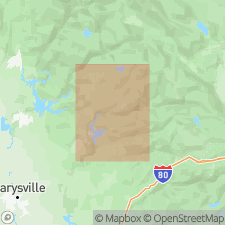
- Usage in publication:
-
- Fiddle Creek Complex
- Modifications:
-
- Named
- Dominant lithology:
-
- Conglomerate
- Siltstone
- Argillite
- Chert
- Sandstone
- Volcanics
- AAPG geologic province:
-
- Sierra Nevada province
Summary:
Name derivation not stated. Consists of all metamorphic rocks west of Dogwood Peak-Gillis Hill fault, excluding Early Jurassic Slate Creek Complex (new), Sierra Co., northern CA. Previously mapped by Hietanen (1976, 1981) as Horseshoe Bend and Franklin Canyon Formations, and Triassic metasedimentary rocks. Fiddle Creek Complex consists of (ascending) late Paleozoic Indian Creek ophiolitic melange [new, informal], early Mesozoic Owl Gulch volcanics [new, informal], early Mesozoic Clipper Gap Formation, and Middle and Late Jurassic Colfax sequence(?) [revised]. Lithology of above named units ranges from (ascending) serpentinite matrix-melange with blocks of volcanic rocks and red-yellow chert; pillowed and massive basalt and felsic tuff; massive black siliceous argillite, prehnite, volcaniclastic sandstone and conglomerate, black ribbon chert with dated Radiolaria, pebbly mudstone, marble olistoliths, tan-gray ribbon chert, talus breccia, detrital serpentinite; well-bedded quartzose wacke, arenite, conglomerate, siltstone and argillite. Total thickness is +/-1 km, of which Owl Gulch volcanics ranges to about 500 m. Contacts among the four divisions of the Fiddle Creek are generally faulted, unexposed, or ambiguous. However, several lines of evidence and key outcrops suggest a stratigraphic succession with internal depositional boundaries. Age is late Paleozoic, early Mesozoic, and Middle and Late Jurassic. Radiolaria from chert at two localities in Clipper Gap yielded ages of Middle and Late Triassic, and Late Triassic and Early Jurassic (Hietanen, 1981). Radiolaria recovered from Clipper Gap chert during present study could only be identified as Mesozoic (D. L. Jones, personal communication, 1983). Felsic tuff from Owl Gulch volcanics yielded zircons dated at 193+/-7 Ma (Saleeby and others, 1988). If this study's broad correlations based on similarities of lithology, age, and stratigraphic succession are correct, then ages of late Paleozoic, early Mesozoic, and Callovian through Kimmeridgian (Middle and Late Jurassic) are suggested. Report includes stratigraphic columns, geologic maps, and cross section.
Source: GNU records (USGS DDS-6; Menlo GNULEX).
For more information, please contact Nancy Stamm, Geologic Names Committee Secretary.
Asterisk (*) indicates published by U.S. Geological Survey authors.
"No current usage" (†) implies that a name has been abandoned or has fallen into disuse. Former usage and, if known, replacement name given in parentheses ( ).
Slash (/) indicates name conflicts with nomenclatural guidelines (CSN, 1933; ACSN, 1961, 1970; NACSN, 1983, 2005, 2021). May be explained within brackets ([ ]).

